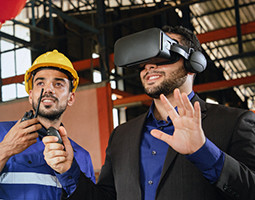April 17, 2025
Are you ready for Education 5.0?
A new framework for digital learning is here. Edtech companies need to keep up with the evolving expectations around how learning should be delivered and experienced.
Education 5.0 is the next step in the evolution of digital learning. Like its predecessor, Education 4.0, this new paradigm is defined in part by the technologies it integrates into the education experience: AI, augmented reality, virtual reality, IoT and blockchain, to name a few.
But Education 5.0 shifts the balance back toward human beings—specifically the human learner. If Education 4.0 brought the power of automation and digital tools to traditional learning methods, Education 5.0 is a tech-enhanced reimagining of how we learn and, just as importantly, how we teach. In particular, it breaks from the traditional teacher-led model in favor of personalized education experiences that a range of new technologies—particularly AI—make possible.
For edtech leaders, the challenge is to keep pace—not just with emerging technologies, but with evolving expectations around how learning should be delivered and experienced. What follows is a closer look at Education 5.0, and at some of the key considerations leaders should keep in mind as they navigate this new terrain.
A balanced approach
What does Education 5.0 look like in practice? Picture an algebra class—not one where every student follows the same pre-drawn roadmap, but one where the learning path is shaped in real time by how each individual brain works best.
If a student grasps mathematical concepts better through visual representation and real-world examples, the system might illustrate quadratic equations with custom visualizations drawn from that student’s interests—say, by plotting the equation-governed arc of a soccer ball in flight. Using language processing (NLP) and sentiment analysis, the system listens for signs of confusion or uncertainty in the student’s voice. Facial recognition, meanwhile, might recognize frustration in a furrowed brow or a set of pursed lips.
In response, the AI tutor might soften its tone, offer a hint, or suggest a quick break to reset. If necessary, it might call in a human teacher for extra support. Later, it might even recommend changes to the lesson plan, giving educators real-time insights to keep the learning both human and high impact.
Writing the next chapter in education
Edtech companies, publishers and universities are already beginning to gear up for the coming of Education 5.0. Across the projects we’re working on, one theme stands out: striking the right balance between powerful technology and individual student needs. Initial results are encouraging. In one case, we partnered with an education company to develop and roll out a bot that lets students generate their own study aids—flashcards, notes and multiple-choice test questions—directly from online textbooks. Students who used the tool saw a significant jump in their semester scores.
On the teaching side, we’re seeing similar momentum. A major K-12 company recently announced a gen-AI-powered tool that helps teachers quickly gauge student comprehension and adjust instruction in the moment. As students work in small groups or individually, the tool analyzes their “open text” responses and gives the teacher a real-time summary of the class’s progress, with constructive feedback and suggestions on how to move forward.
If it sounds like AI is central to many of these efforts, that’s because it is. AI systems, and generative AI, in particular allow machines to emulate human tutors to some degree, and to solve learners’ problems the way a good teacher would. This human-like relatability is essential given the increasing decentralization of the learning process. We need to meet the learners where they are, with learning platforms that can match the efficacy of bricks-and-mortar learning centers, not just in the quality of course materials, but in the flexibility and responsiveness of the teaching.
Three key considerations
As they start building Education 5.0 capabilities into product strategies and roadmaps, here are three considerations for edtech leaders to keep in mind:
1. Incremental improvement, or overhaul?
Because a key aspect of Education 5.0 is its wholesale reimagining of the relationship between technology and learning, it’s critical for edtech companies to assess in advance how it will impact their infrastructure and organization. Will Education 5.0 require incremental improvements or a dramatic shift that could render existing frameworks obsolete? A structured readiness assessment can help provide those answers. The exercise can identify necessary changes at the learner, product and organization levels. Just as importantly, it helps companies start planning for Education 5.0’s impact on their business processes, from product development to implementation to rollout.
Even for edtech companies already adapting to Education 5.0, a readiness assessment can sharpen strategy by helping them explore how different trends might unfold—and what each scenario could mean for their business in the years ahead. For example, the assessment can determine their preparedness to offer the kind of hyper-personalized instruction we saw in the algebra-class example. This kind of tailored learning can help counter enrollment challenges in the education sector, driven by rising student debt and waning confidence in higher education. And it offers a win-win: Students get better experiences, and personalized study paths that align to their preferences and goals, while institutions and publishers see stronger engagement and improved retention.
Before hyper-personalized learning can become a reality, though, providers need to assess how ready their systems are to implement and manage Education 5.0 capabilities like AI, IoT and AR/VR. This is another reason why a formal readiness assessment is essential.
2. New benchmarks
Edtech companies have long relied on key performance indicators such as customer acquisition cost (CAC), customer lifetime value (CLV) and user engagement. But as they invest in Education 5.0, it’s critical to assess whether these metrics are still the right ones—and, if not, to identify better alternatives. New, more useful metrics might include student retention rates, enrollment growth, reduced dropout rates and improvements in student and teacher experience.
Any readiness assessment should focus on defining and aligning around these outcomes. Education 5.0 lets education providers define their own benchmarks and measure the effectiveness of change through comparison. Having the right KPIs encourages an agile, flexible approach to product development—one that meets the evolving expectations of learners, teachers, publishers and institutions, and improves learning outcomes.
3. Agentic AI as the engine of change
Agentic AI is fast emerging as a major force in Education 5.0—one that promises to improve efficiency, enhance stakeholder experience and drive better learning outcomes. We’re currently running workshops and proofs of concept with several leading e-tech companies to explore and move toward more personalized human-led digital learning using agentic AI.
These AI-powered agents are incredibly adaptable. They can serve instructors by creating tutorials, reviewing student work for missed assignments or measuring learning outcomes for specific courses. Within the context of Education 5.0, agentic AI can enable learning that is autonomous, interactive and responsive, adapting in real-time to each student’s learning style, strengths and weaknesses. An agent might, for example, adjust the difficulty level of math problems on the fly based on a review of that student's past performance.
Momentum is building fast. The global education AI market—valued at $3.6 billion in 2023—is projected to soar to $73.7 billion by 2033. And according to research from Microsoft, 47% of educational institutions worldwide are expected to soon be using AI-driven tools in classrooms every day. The stage is set for agentic AI to become the centerpiece of the next generation of learning.
Ready or not, Education 5.0 is moving to the forefront of learning. The question isn’t if it will reshape the edtech landscape, but when, and the time to prepare is now.
Manoj Chawla is a UK-based consulting principal at Cognizant Consulting and domain leader in Education including higher education, publishing and assessment. Manoj brings extensive product development experience and a strategic mindset which helps define business models and solutions utilizing the power of technologies like IoT, AI, Cloud, VR and Analytics.
Sumit is a Consulting Principal in the EdTech sector of Cognizant's CMT practice, focusing on higher education and publishing. He has 14 years of experience working with CRM, ERP, marketing, and commerce on digital transformation and subscription model development for higher education.
Latest posts
Related posts
Subscribe for more and stay relevant
The Modern Business newsletter delivers monthly insights to help your business adapt, evolve, and respond—as if on intuition


















